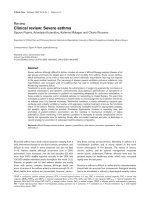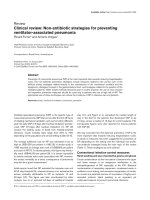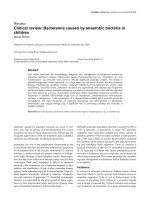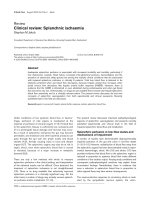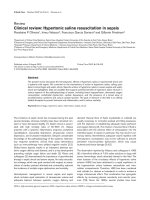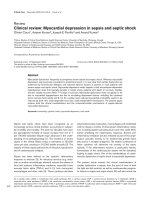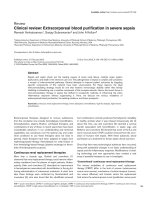Báo cáo y học: "Clinical review: Critical care in the global context – disparities in burden of illness, access, and economics" potx
Bạn đang xem bản rút gọn của tài liệu. Xem và tải ngay bản đầy đủ của tài liệu tại đây (1.15 MB, 6 trang )
Page 1 of 6
(page number not for citation purposes)
Available online />Abstract
World health care expenditures exceed US $4 trillion. However,
there is marked variation in global health care spending, from
upwards of US $7,000 per capita in the US to under US $25 per
capita in most of sub-Saharan Africa. In developed countries, care
of the critically ill comprises a large proportion of health care
spending; however, in developing countries, with a greater burden
of both illness and critical illness, there is little infrastructure to
provide care for these patients. There is sparse research to inform
the needs of critically ill patients, but often basic requirements such
as trained personnel, medications, oxygen, diagnostic and thera-
peutic equipment, reliable power supply, and safe transportation
are unavailable. Why should this be a focus of intensivists of the
developed world? Nearly all of those dying in developing countries
would be our patients without the accident of latitude. Tailored to
the needs of the region, the provision of critical care has a role,
even in the context of limited preventive and primary care.
Internationally and locally driven solutions are needed. We can
help by recognizing the ‘10/90 gap’ that is pervasive within global
health care and our profession by educating ourselves of needs,
contacting and collaborating with colleagues in the developing
world, and advocating that our professional societies and funding
agencies consider an increasingly global perspective in education
and research.
Health and critical care in the developed world
Total world health care expenditures reached US $4 trillion in
2004 [1]. However, there is marked variation in global health
care spending. The US spends the most, US $2.3 trillion, or
16% of the gross domestic product (GDP), whereas median
spending is approximately 10% of the GDP in Canada,
Germany, Switzerland, and France (Figure 1) [2-4]. In the US,
this equates to approximately US $7,000 annually per capita
in comparison with approximately US $3,000 annually per
capita in other Western nations (Figure 2) [5]. In contrast,
total annual expenditure on health in the vast majority of sub-
Saharan African countries is under US $25 per capita and
often less than 3% of the GDP (Figure 3) [6]. These figures
speak to the disparities of a global ‘10/90 gap’: 10% of
worldwide expenditure on health research and development
is devoted to the problems that primarily affect the poorest
90% of the world’s population [7].
National expenditure on health care does not have a
consistent relationship to the overall health of a population.
There is an association between life expectancy at birth and
health care spending, but there is considerable variation in
outcome for a given level of spending (Figure 2). The US is an
outlier, spending more per capita on health care than any
other nation [2] yet ranking poorly on many standard measures
of health among Organisation for Economic Co-operation
and Development (OECD) countries: 46th in average life
expectancy and 42nd in infant mortality [8]. These data
underscore that the determinants of health are often not the
provision of reactive health care per se but are more broadly
related to social circumstances, environmental exposure, and
behavioral patterns [8]. There are also marked regional and
socioeconomic variations in access and outcomes across the
population within developed and developing countries. In
some parts of the developed world, most notably the US,
access to care is far from universal: 45 million citizens, and
millions more immigrants, lack any health insurance [8], and
nearly 90 million lacked health insurance for at least one
month during 2006-2007 [9]. A more comprehensive system
of basic and preventative medical care with more moderate
individual spending through universal health insurance programs
has been associated with much better ranking on standard
measures of health in much of the developed world [5].
Review
Clinical review: Critical care in the global context – disparities in
burden of illness, access, and economics
Robert A Fowler
1,2
, Neill KJ Adhikari
2
and Satish Bhagwanjee
3
1
Departments of Medicine, Sunnybrook Health Sciences Centre, 2075 Bayview Avenue, Room D478, Toronto, ON, Canada M4N 3M5
2
Department of Critical Care Medicine, Sunnybrook Health Sciences Centre, 2075 Bayview Avenue, Room D133a, Toronto, ON, Canada M4N 3M5
3
Department of Anaesthesiology, Johannesburg Hospital, University of the Witwatersrand, Johannesburg, South Africa
Corresponding author: Robert A Fowler,
Published: 9 September 2008 Critical Care 2008, 12:225 (doi:10.1186/cc6984)
This article is online at />© 2008 BioMed Central Ltd
GDP = gross domestic product; ICU = intensive care unit; NNT = numbers needed to treat; OECD = Organisation for Economic Co-operation and
Development.
Page 2 of 6
(page number not for citation purposes)
Critical Care Vol 12 No 5 Fowler et al.
Among various components of health care systems in
developed countries, the provision of care to critically ill
patients is among the most expensive, but very little is known
about international differences in the provision of intensive
care [10,11]. In North America, intensive care consumes up
to 1% of the GDP [12,13], and critical care services tend to
dominate clinical expenditures in other jurisdictions as well
[14,15]. From a global health perspective, resources for
critical care vary considerably. This point is evidenced by the
fivefold or greater variability in the number of intensive care
unit (ICU) beds among Western European countries and by
100-fold differences between Western Europe and some
regions of South America [16].
Health and critical care in the developing world
There are two major challenges to providing critical care in
the least developed countries [17]. First, there is little
infrastructure to deliver health care in general, let alone
conduct observational research regarding capacity. The World
Health Organization does not track global ICU bed availability
or capacity to treat critically ill patients. In the least developed
counties, the discipline of critical care may be poorly
organized, with ICUs usually being ad hoc areas within
hospitals [17]. Specialty trained intensivists are rare. Physi-
cians and nurses are in short supply and underpaid and fre-
quently emigrate to more developed countries [18]. Electrical
power shortage or surges may prevent the use of much
medical equipment, and lack of infrastructure and technical
support for repairs limits equipment life span. Diagnostic
radiology is modest and computed tomography scanners are
rarely available. Oxygen may not be available, and when it is,
in limited supply via oxygen bottles and concentrators, rarely
from evaporators [19]. Transportation is often unavailable or
unsafe [18] and prevents care of critically ill patients in the
few specialized centres that may exist.
The second challenge relates to the premorbid conditions of
patients and their pattern of presentation. Obstetric and
perinatal complications continue to be a major source of
morbidity and mortality. A child born in Angola is 73 times
more likely to die than a child born in Norway; a woman giving
birth in sub-Saharan Africa is 100 times more likely to die
Figure 1
International health spending as a percentage of gross domestic product (GDP), 2006. Reprinted with permission from [3]. Copyright 2006, World
Health Organization.
Page 3 of 6
(page number not for citation purposes)
than in Canada [20]. The burden of illness from motor vehicle
injuries and penetrating torso injuries due to interpersonal
conflict is high [17]. Patients suffer burns due to the use of
fuel-burning lamps and stoves, and burn-related mortality is
similarly high. Malnutrition adds to the above burden of
illness, and sporadically, outright famine leads to devastating
consequences.
Infectious disease is both a common precipitant and final
common pathway to critical illness in the developing world. Sub-
Saharan Africa is experiencing the overwhelming effects of the
AIDS epidemic and is home to 72% of global AIDS deaths [20].
Average life expectancy is 47 years – three decades shorter
than in North America or Europe [20]. With the contraction of
the middle-aged adult population due to AIDS, often grand-
mothers and children are the pillars of health care delivery. The
AIDS epidemic is aggravated by tuberculosis, endemic in much
of Africa. Malaria leads to another 1.5 to 3.5 million deaths
annually [21]. The global incidence of tetanus is approximately 1
million cases per year, with a case fatality rate that can approach
50% [22]. Tetanus is a particularly frustrating critical illness
given that it can be prevented by a simple and safe series of
childhood immunizations.
It may be argued that diseases such as HIV, trauma, and
tetanus are preventable with effective primary health care
programs. In this respect, it is crucial to remember that,
despite centuries of preventive care, we have failed to control
tuberculosis. Indeed, with the advent of multidrug-resistant
tuberculosis, we are facing our greatest battle [23]. The
failure to offer appropriate postprevention therapy similarly
results in collateral family damage and significant reductions
in GDP. This reality is epitomized by the HIV epidemic that
has produced an entire generation of orphans and increased
poverty in many African countries [24,25]. A tiered health
care system that ensures a suitable appropriation of funding
for tertiary and quaternary health care is therefore essential.
Within the medical profession, a common perspective is that
basic health care, including vaccination and nutrition, is not
‘critical care’. However, in many hospital wards of developing
countries, the majority of patients dying of AIDS, complicating
infections, and malnutrition would be designated ‘critically ill’
if cared for in hospitals of the developed world and would be
our patients.
This disparity in health care, capacity for research, and
inability to deliver the care provided by our specialty to the
majority of the world’s population raises ethical concerns. The
developed world has the luxury of spending millions of dollars
studying thousands of patients to detect small differences in
outcomes. As a society and profession, we have spent
billions of dollars in research funding on therapies for severe
sepsis, while millions die each year in countries a short plane
ride away (and likely thousands more disadvantaged citizens
of developed countries) due to limited primary and advanced
health care resources. We are generally excited with numbers
needed to treat (NNT) of 20 to 50 for ICU therapies, and
incremental cost-effectiveness ratios of US $50,000 to
$100,000 per quality-adjusted life year saved. These measures
of cost-efficacy are less impressive when considering an NNT
of 1 to prevent a death with cost-saving therapy for critically ill
patients with AIDS not on antiretroviral drugs [26].
The evolution of disparate economies of the
developed and developing world
Of the nearly 6 billion people in the world today, roughly 1
billion live in extreme poverty. They are nearly all inhabitants of
‘developing’ countries, predominantly in sub-Saharan Africa
and South and East Asia and earn less than US $1 per day
[27]. They are generally too hungry, ill, and destitute to step
on the first rung of the development ladder. Another 1.5
billion are the ‘poor’, living beyond subsistence but still strug-
gling to make ends meet, often migrating long distances for
work, without routine access to safe drinking water and
public health, and one generation from the plight of the
extreme poor. Another 2.5 billion live in the middle-income
world, mostly in cities, with incomes of a few thousand dollars
per year, housing, indoor plumbing, maybe even personal
transportation. Most of us reading this article are within the
Available online />Figure 2
Life expectancy at birth and health spending per capita, 2005. AUS,
Australia; AUT, Austria; BEL, Belgium; CAN, Canada; CHE,
Switzerland; CZE, Czechoslovakia; DEU, Germany; DNK, Denmark;
ESP, Spain; FIN, Finland; FRA, France; GBR, Great Britain; GRC,
Greece; HUN, Hungary; IRL, Ireland; ISL, Israel; ITA, Italy; JPN, Japan;
KOR, South Korea; LUX, Luxembourg; MEX, Mexico; NLD, The
Netherlands; NOR, Norway; NZL, New Zealand; POL, Poland; PRT,
Portugal; SVK, Slovakia; SWE, Sweden; TUR, Turkey; USA, The
United States. Reprinted with permission from [5]. Copyright 2005,
Organisation for Economic Co-operation and Development.
remaining 1 billion rich. Over the last 25 years, only sub-
Saharan Africa has witnessed a rise in the numbers of
extreme poor, with an ‘improvement’ to moderate poverty
occurring in East and South Asia [28]. The good news may
be that more than half the world is on the ladder of economic
development; the bad news, of course, is that at least a sixth
has absolutely no hope of escaping their poverty trap without
the help of others.
Over the last 200 years, the economies of Africa have grown
by approximately 0.7% per year, while the US has grown by
1.7% per year, resulting in a 25-fold increase in living standard
for Americans [29]. There is a common notion that economic
growth of one person or area must come at the expense of
another. For example, the rise of China must be accompanied
by a downturn in the economics of the US, or economic
prosperity in Africa must be achieved by a taking of prosperity
from somewhere else. History does not bear this out; economic
prosperity does not appear to be a zero-sum game [30-32].
Why have some countries failed to achieve economic growth
where others have prospered? The reasons for failed
economic growth are complex and disparate yet many might
be grouped into a few broad categories. There are many
country-specific challenges to economic development, inclu-
ding physical geography, climate change, failure of respon-
sible governance, unjust taxation, and lack of ongoing invest-
ment. Low fertility rates can result in negative population
growth, whereas very high fertility rates can cause scarce
resources to be spread more thinly. Cultural barriers that limit
the involvement of women in the economic, political, and
education system can deny potential contributions of half the
population. Within AIDS-ravaged countries, the middle ages
of the population who would otherwise engage in working,
producing, earning, and caring for the next generation have
been lost, leaving countries of orphan children and grand-
parents. Internal or external military conflict occupies
economic and human capital necessary for development and
changes the focus of individuals and government from
advancement to survival. In 2000, there were globally more
than 1.5 million deaths attributed to violence compared with
other public health priorities [33]. Approximately 90% of this
burden is experienced in low- and middle-income countries
compared with 10% by developed countries [33]. For every
death, there are likely to be 10 people injured and 100 people
displaced [34]. Improving the general economic situation of a
region mitigates this risk. The risk of widespread civil conflict
in a country with a GDP of US $250 per person is 15% over
the following 5 years; the risk is cut in half with a GDP of US
$500 per person and is less than 1% among countries with a
GDP of US $5,000 per person [35].
To be sure, the developed world has some responsibility for
challenges facing the developing world. The developed world
may be able to have its greatest impact by deshackling the
world’s poor from past debt repayment and allowing
Critical Care Vol 12 No 5 Fowler et al.
Page 4 of 6
(page number not for citation purposes)
Figure 3
Total expenditure on health per capita, 2004. Amounts are presented in US dollars. Reprinted with permission from [6]. Copyright 2004, World
Health Organization.
developing countries to reinvest in themselves and investing
enough to allow the least developed countries to get a foot
on the ladder of development. Relief of debt is a key step;
however, it will be of limited value if it is not accompanied by
sustainable economic empowerment and human capacity
development. A recent multicentre study has documented
that, in almost all European countries, rates of poor health
and death are substantially higher in groups of lower
socioeconomic status, providing further incentive to improve
health through improvement of the general situation of the
population [36]. Furthermore, vast local differences in capacity
to deliver health care dictate the need for rigorous engage-
ment with local experts who are sensitive to practical
solutions and a need for limited conditionality accompanying
aid from the developed world.
Hopes and false hopes for the future
The United Nations Millennium Development Goals set a
course toward ending extreme poverty and hunger, ensuring
universal primary education, gender equality, reduction in
child mortality by two thirds, reduction in maternal mortality by
three quarters, reversal of the spread of HIV/AIDS, ensuring
environmental sustainability, and establishment of a global
partnership for development by 2015 [37]. These goals, the
Global Fund to Fight AIDS, Tuberculosis and Malaria, the
United States President’s Emergency Plan for AIDS Relief,
the Gates Foundation, the Clinton Foundation, and the
Gleneagles Agreement give us hope that we are not just
thinking about action but that the developed world is finally
engaging at the highest levels of government.
Although developed countries have increased global health
assistance from US $2 billion in 1990 to US $12 billion in
2004, the Millennium Development Goals will almost surely
not be met. Most OECD countries have not come close to
fulfilling their pledges to donate 0.7% of the gross national
income per year – 7 cents on every US $10 of income [37].
This would lead to approximately US $175 billion per year in
aid, with around US $75 billion coming from the US, a
fivefold increase from current spending. If this occurred,
millions of lives would undoubtedly be saved [38]. Impor-
tantly, the history of economic development would argue that
this initial investment leads to sustained and independent
future development – once people escape the extreme
poverty trap, most are able to continue a rise up the develop-
ment ladder. Indeed, this premise is currently under scrutiny
with the Millennium Villages project [39].
Is it possible to raise this amount of money to help alleviate
suffering in the developing world? Absolutely, yes. The
combined income of only the 400 richest US taxpayers is
greater than the combined GDP of Botswana, Nigeria,
Senegal, and Uganda with a total population of approximately
160,000,000 people. The war in Iraq cost approximately US
$130 billion in direct military outlay in the first 18 months and
US $5 billion per month thereafter [29].
Why we should care about critical illness in
developing countries?
Although many would agree that global economic and health
inequalities demand our attention, should intensivists pay
particular attention to critical illness in the developing world?
We may care because of the potential for simple critical care
interventions to save many lives, or we may react from self-
interest: lack of health care and human well-being in the
poorest of nations may directly affect us via the spread of
infectious diseases or export of violent conflict.
What can we as practicing intensivists do to improve the
situation of global critical illness? There are several courses of
action (Table 1), but the first step is to acknowledge the issue
of global disparities in critical illness prevention and treatment.
What can we do as investigators? In a recent review of the
critical care literature from 2007, we found little research to
report on critical care in the developing world [40]. One
avenue of research may be to perform a needs assessment of
selected developing regions in order to determine the most
common reasons for critical illness, resources available to
manage such illness, and highest-impact interventions for both
preventive and reactive care. It is unlikely that recombinant
proteins or monoclonal antibodies will top the list; yet, in some
areas, intravenous crystalloids, means to concentrate oxygen,
a generator, a vehicle to transport the critically ill to hospital, or
a critical care course or field manual may provide the greatest
return. The critical care community might focus upon already
established Millennium Development Goals of reducing
maternal and childhood mortality. Ultimately, pilot studies to
determine the feasibility and impact of interventions are both
possible and essential. Although it is unrealistic to expect that
Available online />Page 5 of 6
(page number not for citation purposes)
Table 1
What the developed world critical care community can
contribute
Acknowledgment of global disparities in critical illness.
Contact and collaborate with colleagues in developing countries by
sponsoring mutual knowledge transfer programs, including mutual
travel exchanges of qualified intensivists and trainees.
Donate time, knowledge, and resources to organizations already doing
work in the developing world.
Advocate for less expensive medications, including newer generation
antibiotics, analgesia, and sedation as well as less expensive
medications to prevention critical illness such as vaccination and
antiretrovirals.
Mandate our professional societies and funding agencies to consider a
global perspective in research and education support and create a
section within medical professional society task forces on global
disparity with specific aims of reducing disparities through education,
research, and mutual knowledge transfer.
Sponsor attendance of acute care professionals to an upcoming
conference or your own intensive care unit.
focused resources aimed at stabilizing or treating a critically ill
patient in a developing country will be on par with debt reduc-
tion, ensuring adequate education, nutrition, and vaccination
supply, there are undoubtedly cost-effective and feasible inter-
ventions that align with our professional knowledge and skill set.
Conclusion
Achieving the goal of eliminating global poverty and reducing
the burden of disease will require cooperation along many
fronts. The greatest impact will likely be made through multi-
national aid, debt cancellation, fulfillment of the Millennium
Development Goals, and enabling an appropriate spectrum of
primary to quaternary health care. Lest we be accused of
intellectual imperialism, this strategy does not de-emphasize
the key role of local protagonists in providing long-term
sustainable solutions. The developed-world intensive care
community has acquired enormous expertise and expended
considerable resources toward the care of critically ill
patients. Our challenge is to broaden our scope to consider
the majority of the world’s critically ill patients who lack
access to these resources. Currently, the ‘accident of latitude
often determines whether a child lives or dies… this is not the
nightly news, this is a crisis of our world and of our time –
history will judge us and our success’ [41].
Competing interests
The authors declare that they have no competing interests.
References
1. World Health Organization: Composition of world health
expenditures [ />2. Poisal JA, Truffer C, Smith S, Sisko A, Cowan C, Keean S, Dick-
ensheets B: Health spending projections through 2016:
modest changes obscure part D’s impact. Health Aff (Mill-
wood) 2007, 26:w242-253.
3. World Health Organization: International health spending as
percent of gross domestic product (2006) [ />nha/en].
4. Pear R: US Health care spending reaches all-time high: 15%
of GDP. New York Times. 9 January 2004:3.
5. Organisation for Economic Co-operation and Development:
OECD Health Data 2007 [ />0,3343,en_2649_34631_2085200_1_1_1_1,00.html].
6. World Health Organization: Total expenditure on health per
capita, 2005 [ />select_process.cfm].
7. Global Forum for Health Research: 10/90 Report on Health
Research 2003-2004 [ />002__What%20we%20do/005__Publications/001__
10%2090%20reports.php].
8. Schroeder SA: Shattuck Lecture. We can do better—improving
the health of the American people. N Engl J Med 2007, 357:
1221-1228.
9. American College of Physicians: Achieving a high performance
health care system with universal access: what the United States
can learn from other countries. Ann Intern Med 2008, 148:55-75.
10. Edbrooke D, Hibbert C, Corcoran M: Review for the NHS Execu-
tive of Adult Critical Care Services: An International Perspective.
Sheffield, UK: Medical Economics and Research Centre; 1999.
11. Wunsch H, Angus DC: International comparisons of intensive
care: understanding the differences. In Yearbook of Intensive
Care and Emergency Medicine. New York, NY: Springer-Verlag;
2006:786-793.
12. Halpern NA, Pastores SM, Greenstein RJ: Critical care medicine
in the United States 1985-2000: an analysis of bed numbers,
use, and costs. Crit Care Med 2004, 32:1254-1259.
13. Kelley MA, Angus D, Chalfin DB, Crandall ED, Ingbar D, Johanson
W, Medina J, Sessler CN, Vender JS: The critical care crisis in
the United States: a report from the profession. Chest 2004,
125:1514-1517.
14. Chalfin DB, Cohen IL, Lambrinos J: The economics and cost-
effectiveness of critical care medicine. Intensive Care Med
1995, 21:952-961.
15. Hensher M, Edwards N, Stokes R: International trends in the pro-
vision and utilisation of hospital care. BMJ 1999, 319:845-848.
16. Celis-Rodriguez E, Rubiano S: Critical care in Latin America:
current situation. Crit Care Clin 2006, 22:439-446.
17. Bhagwanjee S: Critical care in Africa. Crit Care Clin 2006, 22:
433-438.
18. World Health Organization: The World Health Report (2006):
Overview [ />19. Dunser MW, Baelani I, Ganbold L: A review and analysis of
intensive care medicine in the least developed countries. Crit
Care Med 2006, 34:1234-1242.
20. Gostin LO: Why rich countries should care about the world’s
least healthy people. JAMA 2007, 298:89-92.
21. World Health Organization: Malaria Fact Sheet [http://www.
who.int/mediacentre/factsheets/fs094/en/index.html].
22. Isturiz RE, Torres J, Besso J: Global distribution of infectious dis-
eases requiring intensive care. Crit Care Clin 2006, 22:469-488.
23. Gandhi NR, Moll A, Sturm AW, Pawinski R, Govender T, Lalloo U,
Zeller K, Andrews J, Friedland G: Extensively drug-resistant
tuberculosis as a cause of death in patients co-infected with
tuberculosis and HIV in a rural area in South Africa. Lancet
2006, 368:1575-1580.
24. Bachmann MO, Booysen FL: Economic causes and effects of
AIDS in South African households. AIDS 2006, 20:1861-1867.
25. Kamali A, Seeley JA, Nunn AJ, Kengeya-Kayondo JF, Ruberantwari
A, Mulder DW: The orphan problem: experience of a sub-
Saharan Africa rural population in the AIDS epidemic. AIDS
Care 1996, 8:509-515.
26. Braithwaite RS, Tsevat J: Is antiretroviral therapy cost-effective
in South Africa? PLoS Med 2006, 3:e60.
27. United Nations Millennium Project: Fast Facts: The Faces of
Poverty
/>28. Chen S, Ravallion M: How have the world’s poorest fared since
the early 1980’s? World Bank Policy Research Working Paper
3341. Washington, DC: World Bank; 2004.
29. Sachs J: The End of Poverty: Economic Possibilities for Our
Time. New York, NY: Penguin Books; 2005.
30. Bowles S: Microeconomics: Behavior, Institutions, and Evolution.
Princeton, NJ: Princeton University Press; 2004.
31. Nash JF Jr.: Equilibrium points in n-person games. Proc Natl
Acad Sci U S A 1950, 36:48-49.
32. van Neumann J, Morgenstern O: Theory of Games and Economic
Behaviours. Princeton, NJ: Princeton University Press; 1944.
33. Scott KA: Summary. In Violence Prevention in Low- and Middle-
Income Countries: Finding a Place on the Global Agenda. Wash-
ington, DC: The National Academies Press; 2008:1-6.
34. Scott KA: The intersection of violence and health. In Violence
Prevention in Low- and Middle-Income Countries: Finding a
Place on the Global Agenda. Washington, DC: The National
Academies Press; 2008:36-52.
35. Sidel VW, Levy BS: Collective violence: health impact and pre-
vention. In Violence Prevention in Low- and Middle-Income
Countries: Finding a Place on the Global Agenda. Washington,
DC: The National Academies Press; 2008:171-200.
36. Mackenbach JP, Stirbu I, Roskam A-J P, Schaap MM, Menvielle G,
Leinsalu M, Kunst AE: Socioeconomic inequalities in health in
22 European countries. N Engl J Med 2008, 358:2468-2481.
37. United Nations Millennium Project
[].
38. Labonte R, Schrecker T: Foreign policy matters: a normative
view of the G8 and population health. Bull World Health Organ
2007, 85:185-191.
39. United Nations Millennium Project: Millennium Villages: A
New Approach to Fighting Poverty
[ />40. Fowler RA, Adhikari NK, Sacles DC, Lee WL, Rubenfeld GD: Crit-
ical care 2007. Am J Respir Crit Care Med 2008, 177:808-819.
41. Bono: Forward. In The End of Poverty: Economic Possibilities for
Our Time. Edited by Sachs J. New York, NY: Penguin Books;
2005:xii-xv.
Critical Care Vol 12 No 5 Fowler et al.
Page 6 of 6
(page number not for citation purposes)
